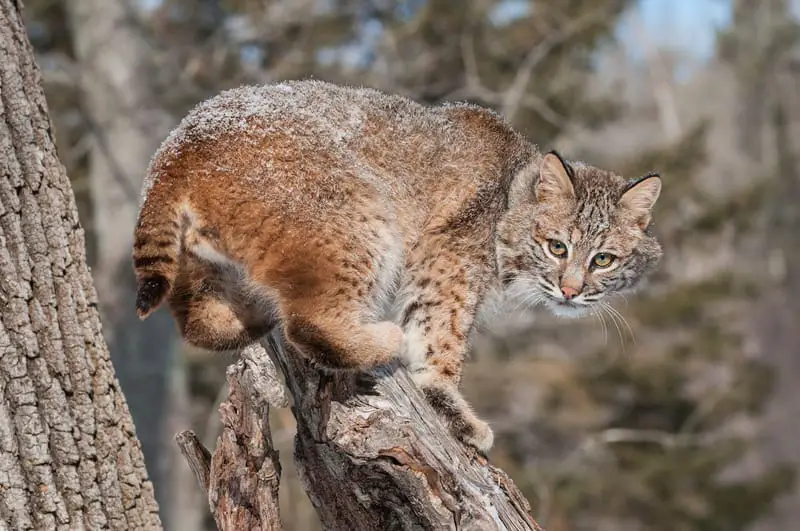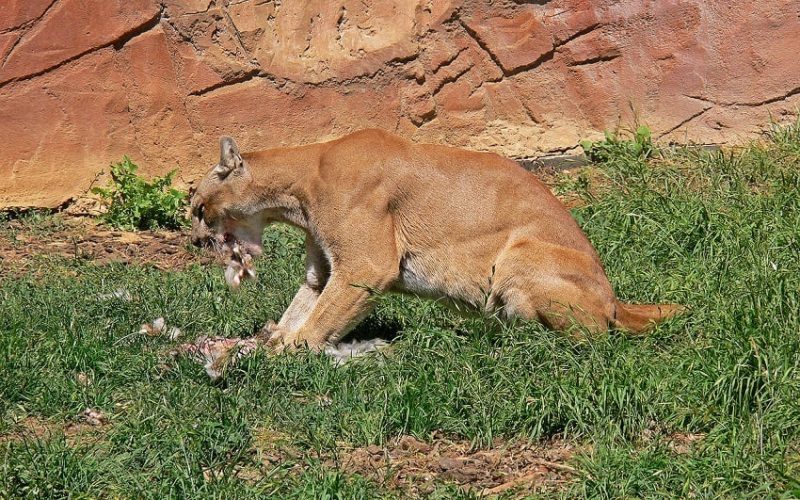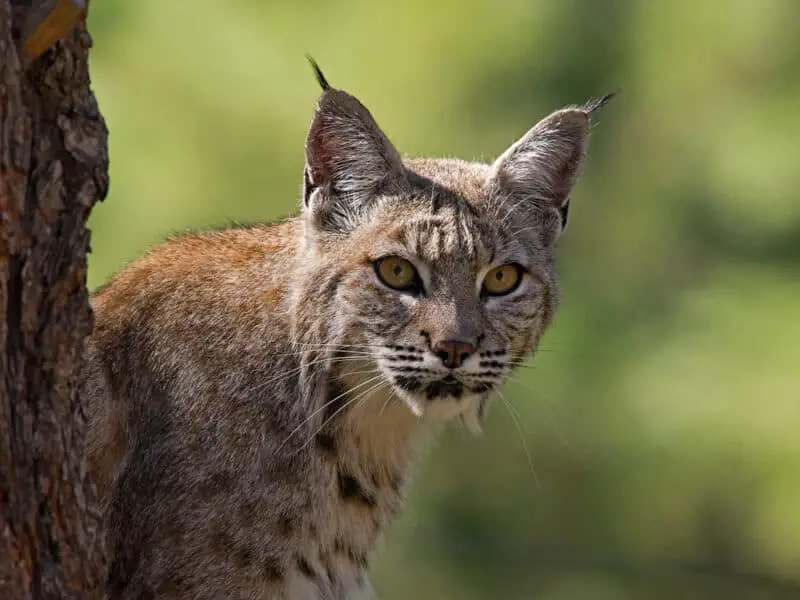Ohio has two native species of wild cats. However, Ohio’s bobcats (Lynx rufus) are the state’s only extant wild cat species. Mountain lions are also native to Ohio but were extirpated from the state by the mid-1800s.
Bobcats in Ohio (lynx rufus)
The Bobcat, also known as the red lynx, is a North American wild cat. The Canada lynx is a cousin of the bobcat. Biologists believe that both the bobcat and the Canada lynx are descendants of the Eurasian lynx, whose ancestors crossed into North America via the Bearing Sea land bridge.
Bobcats are the most numerous wildcat species in North America. Their range begins in Central Mexico and extends north through the United States and into Southern Canada. From there, bobcats become less prevalent northward, and their relative, the Canada lynx, is more numerous. This is because a bobcat’s small feet are not well adapted to traveling over deep snow. On the other hand, Canada lynx have snowshoe-like paws that keep them on top of the snow.
History of Bobcats in Ohio
The bobcat is a vital animal in Ohio’s state culture. After all, Rufus the Bobcat is Ohio University’s official mascot. Bobcats in the Buckeye state have had a tenuis existence at times though. In fact, they disappeared completely from the state for around 100 years before staging a comeback in the mid 1900s.
According to the Ohio Department of Natural Resources bobcat page, Ohio’s bobcats were common before European Americans settled the state. However, they were eliminated from Ohio by 1850. Habitat loss due to human beings converting land to agricultural use and overhunting were the chief causes of their regional extinction.
After their extirpation, bobcats began repopulating Ohio in the mid-1900s. A male bobcat was killed in Scitio County in 1946. This was the first recorded bobcat in Ohio in 100 years. Since then, bobcats have been sighted in the state more often every year. See
The bobcat population has increased sufficiently that it was removed from the Ohio endangered species list in 2014. However, the current bobcat population in Ohio is still being determined.
Ohio Bobcat Conservation Efforts
The Ohio Division of Wildlife is working with researchers to estimate the state’s bobcat population using genetic sampling. They do this by collecting bobcat scat samples and analyzing the DNA. Besides facilitating an estimate of the state’s bobcat population, this research has also provided other vital insights. For instance, researchers determined that the bobcats repopulating Ohio have two genetically unique sub-populations. The eastern population descends from animals from West Virginia and is thought to be self-sustaining. On the other hand, the southern population is continually dependent on bobcats migrating from Kentucky. See Further research indicates that the two populations are merging and interbreeding.
According to the Ohio Division of Wildlife, there is no open season for bobcat hunting or trapping in Ohio at this time. See However ,research done by Ohio Univerity indicates that a limited bobcat harvest could be conducted without adverly affecting the population.
Where Do Bobcats Live in Ohio?
According to an Ohio University study, Ohio’s bobcat population is rising, and there is more potential habitat to facilitate future growth. Their population is the densest in areas with the densest forest growth.
It is a given that the forested areas of southeastern Ohio are the state’s best bobcat habitat. However, the researchers concluded that southwestern and northeastern Ohio also have habitats that can support bobcats. These areas have pastures and other natural habitats that bobcats can utilize for hunting small mammals.
Speaking of northeastern Ohio, a bobcat was sighted twice in the summer of 2022 in the Cleveland parks system. This is the first time a bobcat has been sighted in Cuyahoga County since 1850.
The study also found that central Ohio, dominated by heavy agriculture, lacks natural habitats that bobcats need. See
Bobcats live in a variety of terrains. Look for them in broken habitat types, including riparian woodland, dense forests, ravines, rocky ledges and outcroppings, and field borders.
The mottled pattern of their fur gives them excellent camouflage to live undetected in these environments.
Bobcat Behavior
Bobcats do not hibernate. They are active throughout the year. However, they’re rarely seen since they’re predominantly nocturnal or crepuscular animals. See
A bobcat is a solitary animal, except during mating season or when a female is raising young. It is territorial and lives in home ranges that it patrols and scent marks with urine and feces.
Their territory size varies with the geography and the availability of prey. However, in Ohio, a bobcat’s average range is from 6 to 12 miles. Male home ranges are generally quite a bit larger than female home ranges.
It’s also important to note that male and female bobcat home ranges sometimes overlap.

What Do Bobcats Look Like?
A bobcat is much smaller than a mountain lion and slightly smaller than a Canada lynx. An average bobcat is about twice the size of a domestic cat.
Adult bobcats are 2 to 3 feet long and weigh 15 to 35 pounds. Adult male bobcats are quite a bit larger than females.
These animals have a “bobbed,” short tail with black bands on its upper surface and a black tip on its upper surface but not the back. Their fur is usually gray to brown, with mottled dark spots that range from black to dark brown on the upper parts of the body. They also have black stripes on their inner forelegs and tails.
From a side view, you will notice that a bobcat is slightly higher at the rump than at the shoulders. Bobcats and lynx have long hind legs in proportion to their forelegs.
Bobcats have black-tufted ears. In other words, they have black tufts of hair that poke up on top of the tip of the ears. They have shorter ear tufts than their close relative, the Canada lynx.
The backs of their ears are also black with a white spot in the center. The white spots give the impression of a false eye on the back of each ear.
They also have a whiskered face that seems broader due to their long, ruffled facial hair and whiskers. Their eyes are yellow with round black pupils.
What Do Bobcats Eat?
Despite their comparatively small size, bobcats are aggressive, tough, fierce hunters. At times, particularly in winter, they prey on large mammals much larger than they are, such as white-tailed deer. However, deer are not their go-to prey. They feed on various wildlife, but 95 percent of their diet consists of small prey animals such as rabbits, mice, voles, and squirrels. They are opportunistic feeders and might also feed on such animals as beavers, muskrats, porcupines, birds, reptiles, insects, and carrion. When they reside close to a residential area, their menu might occasionally include small domestic animals and house pets.
Interestingly, they even prey on venomous snakes even though they are not immune to the venom. They accomplish this by using their quickness to pin the snake’s head down with a paw, after which they dispatch the snake with a quick bite to its spine behind the head.
The Venomous snakes in Ohio are: See
- Eastern Copperhead
- Eastern Massasauga Rattlesnake
- Timber Rattlesnake
What Eats Bobcats?
In Ohio, coyotes, domestic dogs, great horned owls, and foxes may occasionally kill young bobcats. Other than that, these felines have no real predators.
Reproduction and Life Cycle for Bobcats
Ohio bobcats may breed at any time throughout the year. However, their main breeding time is from December through May. During the breeding season, a male bobcat may mate with multiple females. If they successfully mate, their gestation periods will last for 60 to 63 days.
After breeding, the male and female go their separate ways. The female takes all responsibility for the selection of a den site and the rearing of the young. Females generally give birth between late April and early May. See
Look for maternal dens in a wooded area. Bobcats use features such as a rock outcropping, hollow trees or hollow logs, ground openings, overturned stumps’ root masses, or the space beneath a fallen tree as denning sites.
A bobcat litter consists of anywhere from 1 to 5 kittens. The average litter size, though, is around 3. Bobcat kittens have their eyes when they’re born, just like domestic cats are. However, their eyes will open when they are a week to 10 days old. By the time they are 2 months old, they will have replaced their spotted baby fur with a haircoat similar to what their parents have.
By mid-July, the young kittens venture out with the mother bobcats to fine-tune their survival skills. Their training may last into the early winter. By mid-winter, the kittens strike out on their own.
Female bobcats reach sexual maturity at 1 year of age, while males reach sexual maturity at age 2.

Mountain lions in Ohio (Puma concolor)
Since they live in a wide geographical area, mountain lions have a long list of regional names. In recent years, their scientific name has been changed from Felis concolor to Puma concolor. Some common names for mountain lions are cougar, panther painter, Andean Mountain lion, and puma.
Where are mountain lions typically found?
Mountain lions live on all three of the American continents. Their range begins in Canada’s Yukon territory and extends south through parts of North America, Central America, and South America to the southern tip of Argentina.
The biggest populations of cougars in Canada are in British Columbia and Alberta. In the United States, they mainly live in the western United States and Florida in the southeast. In Florida, the cougar is called the Florida panther.
Although mountain lions are also native to most of the eastern and midwestern United States, they have been extirpated from most of this territory.
Mountain lions are native to Ohio. However, they have been extirpated from the state since the early to mid-1800s.
People occasionally see mountain lions in Ohio. However, most of these sightings are of loose captive mountain lions.
Also, occasionally, young male mountain lions from established populations travel large distances looking to establish their own territory. An example of this happened in 2011 when a young male cougar traveled over 1,500 miles from the Black Hills of South Dakota to be struck by a car and killed in Connecticut. See
Whatever the source of Ohio mountain lion sightings, the Ohio DNR does not see any sign of a breeding mountain lion population in the state at this time.
What do mountain lions look like?
To visualize what a mountain lion looks like, picture a giant house cat with short, light brown fur. Mountain lions are much larger than domestic cats, though. Average house cats weigh in at around 10 pounds, while male mountain lions can weigh over 200 pounds.
These large cats have muscular, slender bodies, rounded small heads, and upright ears that are oval at the tip. Another characteristic that mountain lions have is their muscular long tails, which account for almost one-third of the entire length of the animal. They use their long tail for a counterbalance, moving it from side to side as they navigate through uneven terrain.
Mountain lions have a tan coat of short, coarse hair over most of their body. The area around their nose, the tip of their tail, and the tips of their ears are black. Their belly, the area above their upper lip, below their lower lip, and their chin are all white. They also have a sprinkling of dark hair on their backs. There are some coat color variances between different geographic locations.
How large are mountain lions?
Mountain lions are the second largest cats in the western hemisphere, smaller only than the Jaguar (Panthera onca). However, worldwide, the African Lion (Panthera leo) and the Tiger (Panthera tigris) are also larger.
Male and female mountain lions are phenotypically identical in every respect except for size. Males are 30 to 40% bigger than females. Though sizes vary considerably throughout the cat’s geographic range, an adult male typically weighs between 110 and 180 pounds, 50 to (82 kgs). A rare few of them grow bigger than 200 pounds (91kgs). Female mountain lions or queens average between 80 and 130 pounds (36 to 59 kgs). Adult males or toms will reach a length of 6 to 8 feet (1.8 to 2.4 M) from their snout to the tip of their tail. On the other hand, adult females are 5 to 7 feet long (1.5 to 2.1 M).
Large cats, but not big cats
An interesting fact is that while an adult mountain lion might be a large cat or maybe even a big cat, they are not taxonomically classified as big cats because they cannot roar. Snow leopards, for example, are smaller than mountain lions, but since they can roar and cannot purr, they are classified as big cats, while mountain lions are not. Another interesting thing that I can mention here is that mountain lions purr.
Since mountain lions cannot purr and cannot roar, they are in the Felis genus, while big cats that cannot purr and can roar are in the Panthera genus.
Biologists taxonomically divided mountain lions into two sub-species in 2017. The first is (Puma concolor couguar) or northern cougar. Northern cougars range through North America, Central America, and possibly northwestern South America. The second sub-species is (Puma concolor concolor) or southern cougar. These cats range only in South America.

What do mountain lions eat?
Mountain lions account for around 18 pounds of biomass and consume around 10 pounds of meat per day. To do this, an adult mountain lion has to kill a deer or a deer’s equivalent in meat around once a week. Mountain lion populations in the western United States go up and down with deer populations. A mountain lion’s preferred prey is deer. However, they also prey on other animals.
Ohio mountain lion prey would include the following animals:
- white-tailed deer
- livestock
- coyotes
- raccoons
- rabbits
- wild turkeys
- miscellaneous birds
- various small rodents
- thirteen-lined ground squirrels
- porcupines
- skunks
- snakes
- pets
- feral cats
- bobcats
Mountain lion behavior
Mountain lions are solitary, territorial animals. It’s a rarity to see two or more together unless during mating or in the case of a female raising young. They have expansive home ranges.
They have expansive home ranges. In fact, an adult male cougar’s home range usually is more than 100 square miles and up to 250 square miles. They will sometimes mark their territory by leaving claw marks on trees. They also scratch up piles of leaves or pine needles they urinate on as a scent marker. Male mountain lions sometimes fight to death to defend their territory.
In Conclusion
Get outside and experience the beauty of Ohio’s outdoors. You might never see a bobcat. They’re very illusive animals. You can train yourself to spot evidence of their presence, though. This might include their tracks, their fur, or evidence of their kills. Whether hiking through southeastern forests or visiting local parks, embrace the adventure that awaits you!
While enjoying the outdoors, remember that your exploration contributes to the awareness and appreciation of Ohio’s wildlife. Support conservation efforts by advocating for the protection of these habitats, ensuring that our wild cats and their ecosystems thrive for generations to come. Let’s celebrate Ohio’s natural heritage together!
Recent Posts
The only venomous snakes in Washington State are Northern Pacific Rattlesnakes. The Northern Pacific Rattlesnake (Crotalus oreganus oreganus) is a sub-species of the Western Rattlesnake. Anyone...
Skunks are not classified as true hibernators. But they go into a state of torpor when the weather gets cold. Skunks are light sleep hibernators, along with opossums, bears, and raccoons. ...

